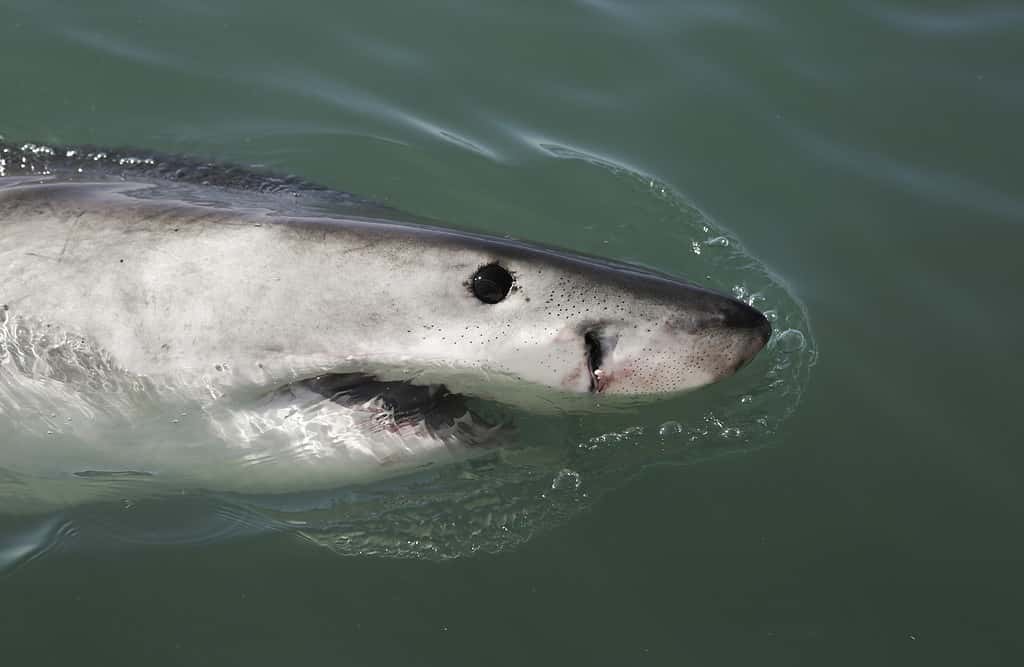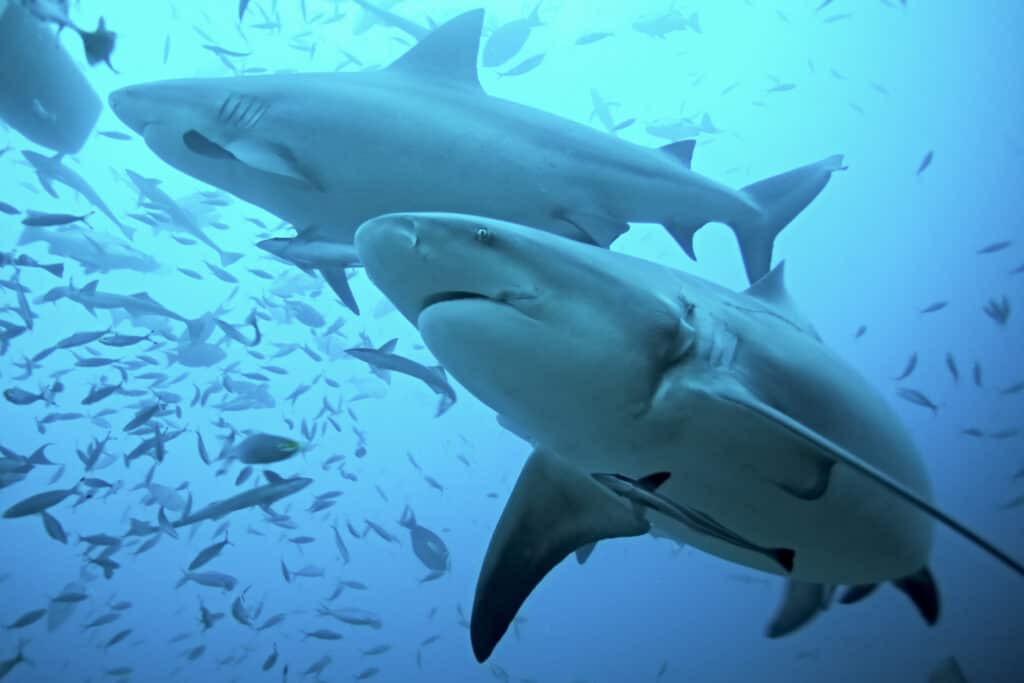Just as this kid is climbing out of the water into the boat clutching a fish that they have caught, a shark decides that it would quite like the fish itself! As the video shows, sharks are very good at sneaking up on things in the water!
Click The Link Below To Watch The Full Video!
Sharks As Successful Predators

The
tiger
shark gets its name from the vertical lines that run along the side of its body.
©iStock.com/Divepic
We don’t know the species of this particular shark but it is clearly very interested in the fish! As a carnivore, this shark must be able to detect prey in and on the water so that it can launch an attack. To enable them to do this, many sharks have complex brains that enable them to process information from many senses at the same time.
How Do Sharks Use Sight And Smell To Find Prey?

Some sharks use sight, smell, sound, touch, taste and their electro-sensory system to detect prey
©iStock.com/pkphotoscom
Light does not travel as well through water as it does through the air so seeing things at a distance is always going to be a challenge. Therefore, a shark relies on its other senses until the prey is around 50 feet away. Nevertheless, it has some useful eyesight adaptations that assist with hunting.
Their eyes are positioned on the side of their head so they are able to see nearly all around them. Similar to cats, they have a reflective layer of shiny cells called the ‘tapetum lucidum’ which improves vision in low light conditions. It’s particularly helpful for species that hunt in deep water and at night when light is minimal.
In contrast, smell is hugely important to sharks, and up to two-thirds of the total weight of their brain is employed in interpreting smells. In this way, they are able to detect prey, potential predators, and potential mates. Some species have super smell detection and can detect one part of blood in one million parts of water.
Sharks Using Sound, Touch, And Taste

©Jayaprasanna T.L/Shutterstock.com
Some sharks are great at picking up low-frequency signals allowing them to track wounded prey. They may have nerve endings in their skin and pressure-sensitive nerves in their teeth. Some species use a ‘test bite’ to get more information but this can prove fatal for the creature on the receiving end!
Finally, they have a complex electro-sensory system involving organs called the ampullae of Lorenzini. We are still learning how these help sharks to detect prey and to navigate their migration journeys.
Common Types of Sharks Found in Australian Waters
Within the country, there are four types of sharks that are most commonly documented for their attacks or encounters with humans: the bull shark, tiger shark, oceanic whitetip shark, and the great white shark. These sharks are vital for maintaining marine ecosystems in Australia. Conservation and protection are crucial. While encountering sharks can be awe-inspiring, it is important to approach their habitats with caution and practice responsible behavior for the safety of both humans and sharks.
Is This Normal Behavior?
There have been plenty of tales (and video footage) of sharks snagging fish caught by humans. Given their sharp senses which we have already discussed, a shark in the vicinity of a fish being captured would be tempted to jump in–especially if there was blood in the water. A struggling fish, being slowly dragged towards a boat or shoreline, would certainly be tempting!
Sharks do indeed prefer the sneak attack. They have the ability to avoid the field of vision of their prey, whether it be fish or humans. Was this shark drawn by the fish or the boy that was holding it? Only it can answer that!
Which Sharks Attack Humans The Most?

Bull sharks are aggressive and one of the most dangerous sharks.
©Martin Prochazkacz/Shutterstock.com
Bull sharks are known to be super aggressive. In fact, bull sharks are noted as one of the most dangerous sharks globally. Bull sharks are similar to their other well-known relatives, great whites, and tiger sharks, making these three species the most prone to human attacks.
The United States and Australia have the highest number of sharks in the world. The great white shark holds the record for the highest number of unprovoked attacks, with a total of 333 incidents, including 52 fatalities.
In contrast, the leopard shark is one of the least threatening shark species, as it has never been reported to harm or bite humans.
How Big Do Sharks Get?

Some sharks, like the great white, are much bigger than a human.
©Willyam Bradberry/Shutterstock.com
Sharks come in all sizes – from the 60-foot-long whale shark to small aquarium-sized sharks – each species is unique in size and appearance. For the purposes of this article, we will focus on sharks that are found in Australian waters.
Out of 400 species of sharks, around 180 have been spotted in Australian waters – with 70 species that are thought to be endemic. The sharks most commonly seen in the ocean are mako sharks, (can grow up to 8 feet), great whites, (can grow up to 20 feet), basking sharks, (can grow up to 49.8 feet), and porbeagles, (can grow up to 8.2 feet). Sharks swimming in the freshwater currents are bull sharks, (can grow up to 11.5 feet ), and tiger sharks, (can grow up to 24.6 feet).
Unfortunately, we don’t know what kind of shark stole the boy’s fish in the video – but let’s be glad that it was a small one!
The photo featured at the top of this post is © iStock.com/Alessandro De Maddalena
Thank you for reading! Have some feedback for us? Contact the AZ Animals editorial team.






